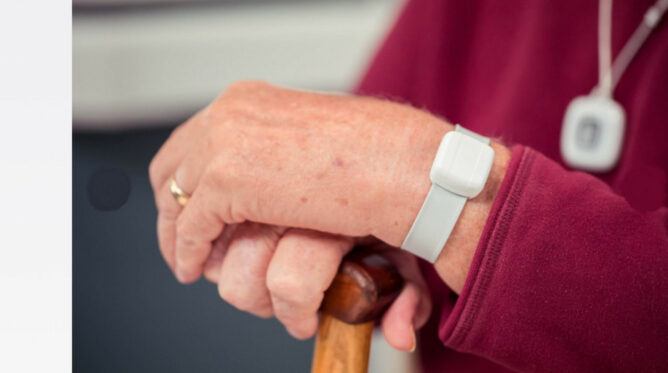In this article, I will be reviewing one of the leading wander management systems, the Wanderguard. This Stanley Wanderguard Bracelets Review will distinguish between WanderGuard BLUE Wearable and WanderGuard BLUE Tag. It will also guide you through the selection process to reassure you the best one for your parent or loved one.
I would start with a personal scenario.
“Papa, would you like some blueberry muffins?” I asked my grandpa, who was watching a basketball game. He nodded his consent. So, I moved to the kitchen to get some muffins and coffee for both of us. Unfortunately, when I went back to the living room, my grandpa was gone. The door leading outside was wide open, and his favourite coat was gone from the coat hanger. He wandered again.
This scenario is familiar to most of us, especially those who work in elderly care homes (aged care). Or maybe those that are living with their elderly parents or grandparents suffering from Alzheimer and dementia.
But, what exactly is wandering? How can we manage this? What is wander guard technology? Which brand of wander guard technology should I use? We are going to answer all these in this article, stay with me.
What is Wandering?
Wandering is often seen in people who are suffering from dementia or memory issues. It is a situation where they leave or forget how to get to their home or a place, so they, therefore, roam about, without their caregiver knowing.
This is often because they are confused and in search of home when they may already be at home.
Wandering is a scary experience to the wanderer as well as to the caregiver because wanderers may injure themselves, fall victim to predators or be lost in a large city teaming with thousands of people.
You may not know where to start to search from, if you have ever experienced it as a carer.
Causes of Wandering | Who is at Risk of Wandering?
Below are the two main reasons for wandering.
- People suffering from Alzheimer (e.g. dementia)
- Late stages of Parkinson’s disease, or
- Any other Disease associated with Dementia
Ways to Prevent Wandering
If your loved one is prone to wander, it’s important to implement some strategies to prevent he/she wandering.
Here are some valuable day to day tips.
Establishing a routine
Structuring the daily activities of people suffering from dementia can go a long way to reduce wandering. When they are participating in activities the likelihood of wandering is reduced. It also reduces the feeling of restlessness.
Examples of activities: taking a walk with someone, listening to music, watching a TV, cooking, any helping hand etc.
Keeping them comfortable
When they want to visit the bathroom or take a cup of water is normally the time they wander. Try to ensure their basic needs are met.
Keep people informed
Informing your neighbours, friends, acquaintances to alert you whenever they see them alone is always a good idea.
Use the technology
You can install an alarm system to alert you whenever a particular window or door is opened.
Another alternative is to simply hang a bell over the door or window.
Tracking and identification
You can arrange them to wear an I.D bracelet or card containing your contact info and other details on them, so you can be notified if someone finds them wandering.
Technology can go a long way in helping keep track of the activities of our loved one’s and also keep them safe.
One of such technologies is the Wander Guard technology.
What is Wander Guard Technology?
Wander Guard is technology made solely for the purpose of keeping elderly people or people with dementia from wandering. Wander Guard’s devices alert the caregiver whenever his or her ward breaches a perimeter or strays too far.
This technology is used in eldercare communities or nursing homes or even at homes where people live independently.

Tip: You may find our Guide on Pressure Ulcer Prevention for Elderly and Bed-ridden Patients useful.
One example of the technology is the Stanley Healthcare’s Wander Guard.
These technologies are immensely helpful thanks to their features. For example,
- You receive a notification or alert when a resident from your ward or an elderly parent is breaching an off-limit area in your home etc.
- When they are agitated and violent
- It is GPS enabled, what this means is that you will always know the particular place they are when they are missing.
There are a few Wander guard systems in the market available for monitoring our elderly one’s. We will look at one product we think is perfect, which is the Stanley Healthcare Wander Guard.
Wanderguard BLUE Wander Management System
These are a range of products from the Stanley Healthcare company. These products help in the protection and monitoring of patients or people suffering dementia or memory loss, so that they won’t wander or elope.
They are two products from the Wanderguard BLUE Wander Management range.
They are:
- Wanderguard blue Tag
- Wanderguard blue Wearable
Let’s review them in detail now.
Wanderguard BLUE Tag
This is a small yet powerful device that incorporates minimalistic design for easy use and understanding.
Key features and Pros
- It is available in two options: a 90 days tag (WGB-TAG-1000-90D) or a 3-year tag (WGB-TAG-1000-3Y)
- It is whitish-grey in color.
- It comes with the battery life of 90 days and three years. 90 days for the 90 days tag and 3 years for the 3-year tag.
- IP67 compliant, which means it is dust and water-resistant.
- Smooth surface for easy cleaning or sanitizing.
- It is wireless.
It can be managed by Wanderguard Blue Manager Mobile Application and also detected by Wanderguard Blue Detector Tool.
- The tag has a unique serial number for identification.
- It comes with standard wristbands
- Apart from the standard wristband, you can wear this device with a cut-proof Securaband wrist band.
- Light and comfortable.
It is lightweight and it is worn like a bracelet. The wearer won’t even know that he or she wore it. It’s that simple.
Saying so, there is one limitation based on our experience with this device.
Cons
- It may not give the precise location of the wanderer like the Wanderguard wearable.
How does it work?
- Wear and secure the tag on the wrist of the at-risk person.
- Activate the tags using the detector tool
- When the at-risk person approaches the door which is within the low-frequency range of as set in the controller.
- The tag sends a Bluetooth energy signal to the controller for it to lock the door.
Our Rating
4.0
Now, let’s compare the Tag with the Wanderguard Wearable unit, which meant to be a more advanced device.
Wanderguard BLUE Wearable
Here are the advantages of Wanderguard Wearable.
Key features and Pros
- It is available in two option: a 1-year tag and 3-year tag
- These tags are also available in two band lengths: shorter and longer bands
- They come in standard bands
- It is black in color
- They look like high tech wristwatch
- Also dust and water-resistant (IP67 compliance)
- Comes in with a unique serial number
- The tags beacons and its signals can be detected by Gateway GW3000/GW3100 and displayed through the Arial software. Meaning half the precise location of the patients or Individual are known.
- Wireless
- The bands come attached to the tag
- Battery life. The 1 year and 3-year wearable tags have a battery life of a year and three years, respectively.
Cons
- It may be difficult for the caregiver to remove if there is no proper orientation or coordination.
Our Ratings
4.5
How does it work?
- Wear and secure the tag on the wrist of the at-risk person.
- Activate the tags using the detector tool.
- When the at-risk person approaches the door which is within the low-frequency range of as set in the EX5700 controller.
- The tag sends a Bluetooth energy signal to the EX5700 controller for it to lock the door.
Conclusion
Final words…
Fear of our loved one’s wandering shouldn’t be a problem again. Technologies like Stanley healthcare’s Wanderguard Blue Wander Management offers a seamless way for caregivers to protect and monitor the whereabouts of our loved one’s and patients.
Tip: If the loved one is with diabetes, consider a Diabetic Medical Alert Bracelet too.









